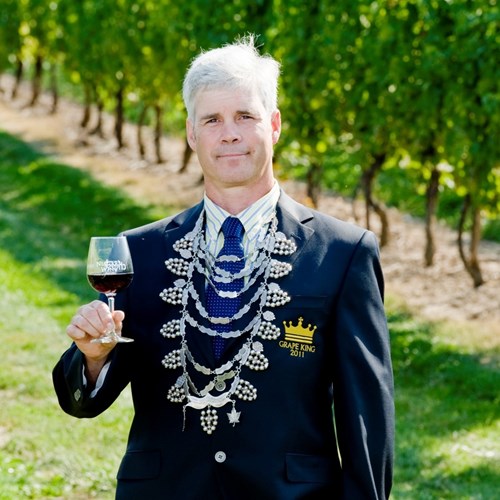Ed Hughes
A chance meeting with former Niagara winemaker Deborah Paskus lead to a contract for Vineland grape grower and former chef Ed Hughes, and a desire to learn more about the industry in 1994.

While supplying grapes for Paskus while she was the winemaker at Tawse Winery, Hughes’ lifelong desire to learn was tweaked. Caroline, Ed’s wife and partner on their 21-acre farm, says Ed “got a lot of new and innovative ideas from her.” This mentoring would continue with Ed starting to do research with Paskus to improve the quality of the grape, yielded through high density planting while moving towards a more natural way of growing.
Wanting to learn more about not only grape growing but winemaking as well, Hughes started studies at Brock’s Cool Climate Oenology and Viticulture Institute in 1999, and by taking one or two courses a semester while working the farm and catering to various wineries, he graduated with a certificate in 2007. “It was everything about grape growing and winemaking without all the research,” he says.
While he didn’t take all the research courses offered in CCOVI’s degree program, he admits what he learned continues to help him today. “I know the questions to ask. That’s what I got out of Brock,” he says. “I do have that instinct to find things out, and after graduating I knew what to do.”
Studying at Brock brought him into contact with other mentors like Adjunct Professor, Biological Sciences, Wendy McFadden-Smith, who is also Tender Fruit and Grape IPM Specialist with the Ontario Ministry of Agriculture, Food and Rural Affairs; and Viticulture Research Chair Andy Reynolds. With input from them, he began a bio-diversity research project on his farm ; trying to reduce or eliminate the use of insecticides through the use of cover plants and about 20-30 insects (including parasitic flies and wasps that eat the larva of the other bugs, thus reducing the presence of mites that organic growers face) while maintaining high quality and tonnage. The idea, he says, is to create an environment that these helper insects are attracted to. “The more robust use you have, the better the control.” He’s also gone to a no-till system, reducing the number of tractor passings, saving on diesel costs and its effect on the environment.

